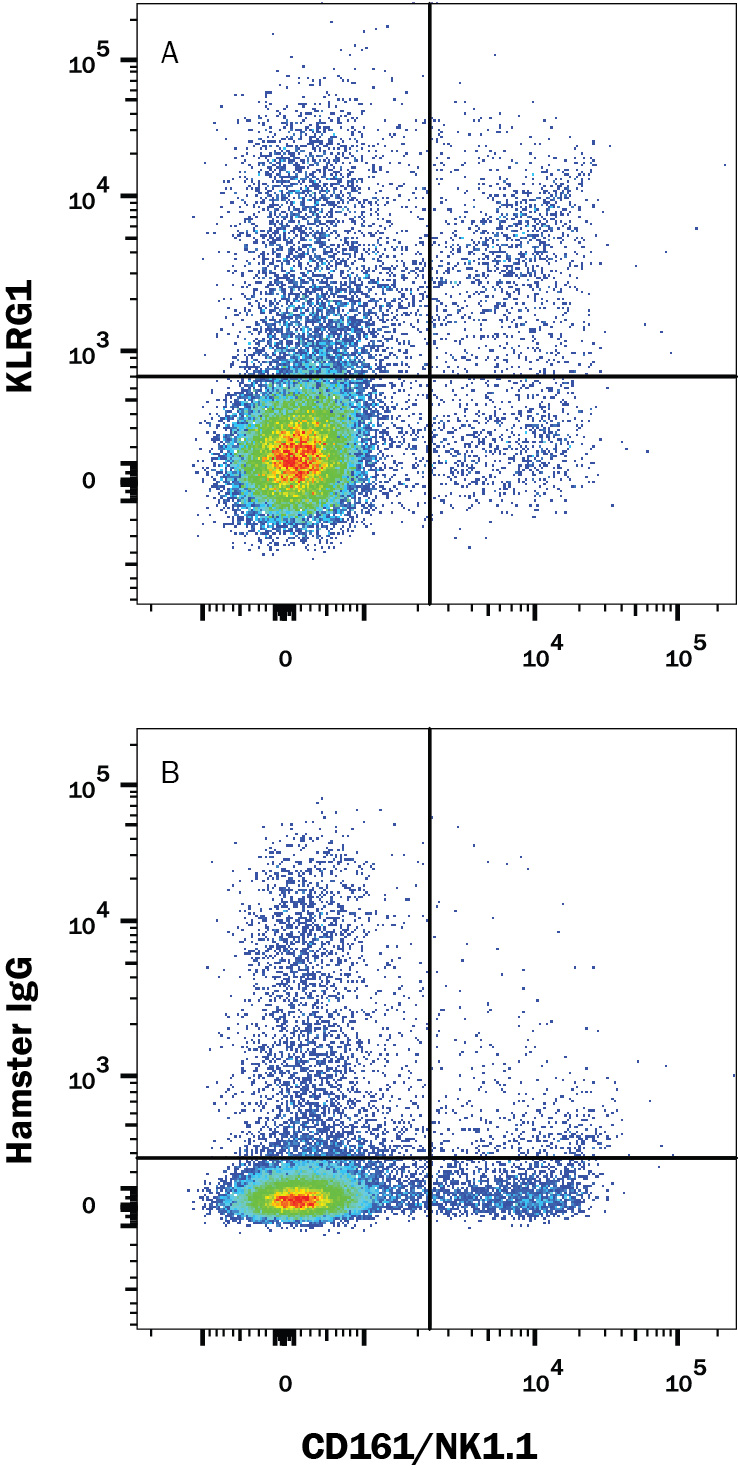Mouse KLRG1 Antibody Summary
Applications
Please Note: Optimal dilutions should be determined by each laboratory for each application. General Protocols are available in the Technical Information section on our website.
Scientific Data
 View Larger
View Larger
Detection of KLRG1 in Mouse Splenocytes by Flow Cytometry. Mouse splenocytes were stained with Rat anti-Mouse CD161/NK1.1 PE-conjugated Monoclonal Antibody (Catalog # FAB8319P) and either (A) Hamster Anti-Mouse KLRG1 Monoclonal Antibody (Catalog # MAB69441) or (B) Hamster IgG control antibody followed by APC-conjugated Anti-Hamster IgG Secondary Antibody. View our protocol for Staining Membrane-associated Proteins.
Reconstitution Calculator
Preparation and Storage
- 12 months from date of receipt, -20 to -70 degreesC as supplied. 1 month, 2 to 8 degreesC under sterile conditions after reconstitution. 6 months, -20 to -70 degreesC under sterile conditions after reconstitution.
Background: KLRG1
KLRG1 (Killer cell Lectin-like Receptor G1), also called MAFA (Mast cell Function Associated), is an inhibitory type II transmembrane glycoprotein of the C-type lectin family, designated CLEC15A (1). Mature mouse KLRG1 consists of a 33 amino acid (aa) cytoplasmic domain with one Immunoreceptor Tyrosine-based Inhibitory Motif (ITIM), a 23 aa transmembrane segment, and a 132 aa extracellular domain (ECD) with one C-type lectin domain (CTLD) (2). Within the ECD, mouse KLRG1 shares 57% and 80% aa sequence identity with human and rat KLRG1, respectively. Alternate splicing generates additional isoforms of mouse KLRG1 that lack either the CTLD or the CTLD, transmembrane segment, and a portion of the cytoplasmic domain (3). KLRG1 is expressed as a 30 - 40 kDa N-glycosylated molecule that forms disulfide-linked homodimers, trimers, and tetramers (4, 5). It is expressed on subpopulations of CD8 + CD4 + regulatory, and gamma/delta T cells as well as on NK cells (2, 4, 6 - 8). KLRG1 is expressed on T cells found in cord blood, but it is down-regulated postnatally and is subsequently re-expressed on antigen-exposed T cells (7, 9). It is expressed by a greater proportion of CD8 + T cells in the elderly and by virus-specific CD8 + T cells during chronic virus infection (10 - 12). KLRG1 binds to E-, N-, and R-Cadherins, triggering ITIM-dependent KLRG1 signaling and inhibition of T cell activation (5, 13, 14). The response is bi-directional, as KLRG1 binding to E-Cadherin on dendritic cells (DC) can induce an anti-inflammatory DC phenotype (increased IL-10 production and decreased IL-6 and TNF-alpha production) (15).
- Henson, S.M. and A.N. Akbar (2009) Age 31:285.
- Hanke, T. et al. (1998) Eur. J. Immunol. 28:4409.
- Voehringer, D. et al. (2001) Immunogenetics 52:206.
- Corral, L. et al. (2000) Eur. J. Immunol. 30:920.
- Rosshart, S. et al. (2008) Eur. J. Immunol. 38:3354.
- Voehringer, D. et al. (2002) Blood 100:3698.
- Beyersdorf, N. et al. (2007) Eur. J. Immunol. 37:3445.
- Eberl, M. et al. (2005) J. Leukoc. Biol. 77:67.
- Marcolino, I. et al. (2004) Eur. J. Immunol. 34:2672.
- Ouyang, Q. et al. (2003) Exp. Gerontol. 38:911.
- Thimme, R. et al. (2005) J. Virol. 79:12112.
- Cush, S.S. and E. Flano (2011) J. Immunol. 186:4051.
- Ito, M. et al. (2006) J. Exp. Med. 203:289.
- Tessmer, M.S. et al. (2007) Int. Immunol. 19:391.
- Banh, C. et al. (2009) Blood 114:5299.
Product Datasheets
Citation for Mouse KLRG1 Antibody
R&D Systems personnel manually curate a database that contains references using R&D Systems products. The data collected includes not only links to publications in PubMed, but also provides information about sample types, species, and experimental conditions.
1 Citation: Showing 1 - 1
-
Functionalized nanowires for miRNA-mediated therapeutic programming of naïve T cells
Authors: Yee Mon, KJ;Kim, S;Dai, Z;West, JD;Zhu, H;Jain, R;Grimson, A;Rudd, BD;Singh, A;
Nature nanotechnology
Species: Transgenic Mouse
Sample Types: Whole Cells
Applications: Flow Cytometry
FAQs
No product specific FAQs exist for this product, however you may
View all Antibody FAQsReviews for Mouse KLRG1 Antibody
There are currently no reviews for this product. Be the first to review Mouse KLRG1 Antibody and earn rewards!
Have you used Mouse KLRG1 Antibody?
Submit a review and receive an Amazon gift card.
$25/€18/£15/$25CAN/¥75 Yuan/¥2500 Yen for a review with an image
$10/€7/£6/$10 CAD/¥70 Yuan/¥1110 Yen for a review without an image


